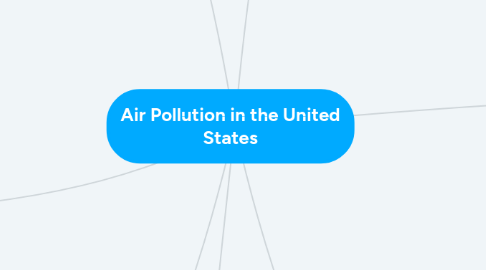
1. Cause
1.1. Natural Gas Usage
1.1.1. offsets the falling levels being realized by the decline in coal being burned by electricity-generating plants in the United States
1.2. Transportation
1.2.1. emissions from cars increase levels of carbon monoxide and other greenhouse gases
1.2.2. According to EPA, motor vehicles cause 75% of carbon monoxide pollution
1.3. Wildfires
1.3.1. release large amounts of smoke and fine particles into the air
1.3.2. Big fires, especially in California in 2018, played a role in raising the total national air pollution
2. 6 Major Pollutants in the Air
2.1. Particle Matter
2.1.1. its microscopic size means it can be inhaled and put into a person's blood stream
2.1.2. can damage a person's respiratory system, reach the brain and send people to the emergency room
2.2. Carbon Monoxide
2.2.1. reduces the amount of oxygen that can be transported in the blood stream to important organs
2.2.2. comes from vehicle emissions
2.3. Ground-level ozone
2.3.1. colorless and highly irritating gas that forms just above the earth's surface
2.3.2. can trigger different health problems like chest pain, coughing, throat irritation, and congestion
2.4. Sulfur Oxides
2.4.1. produced from the burning of fossil fuels
2.4.2. forms sulfuric acid, which is the main component of acid rain
2.5. Nitrogen Oxides
2.5.1. contributes to the formation of pollution particles and oxides
2.6. Lead
2.6.1. can be inhaled or can be ingested
2.6.2. toxic to plants and animals
2.6.3. affects the central nervous system
3. Legislature
3.1. Clean Air Fund
3.1.1. $50 million in initial funding with a goal of raising a total of $100 million
3.1.2. supports organizations around the world working to fight air pollution, improve human health, and accelerate carbonation
3.2. Clean Air Act
3.2.1. Clean Air Act enforcement actions fell in the first two years of the Trump administration
3.2.2. was initially made to control air pollution levels nationally
3.2.3. reduced key air pollutants that cause smog and particulate pollution by more than 60%
3.2.4. federal law that regulates air emissions from stationary and mobile sources
4. National Ambient Air Quality Standards (NAAQS)
4.1. Primary
4.1.1. set limits to protect public health, including the health of "sensitive" populations such as asthmatics, children, and the elderly
4.2. Secondary
4.2.1. set limits to protect public welfare, including protection against visibility impairment, damage to animals, crops, vegetation, and buildings
4.2.1.1. Website for actual NAAQS Charts: https://www.epa.ohio.gov/dapc/general/naaqs
5. Effects
5.1. Public Health
5.1.1. ozone and particulate matter were estimated to contribute 8 to 21% and 3 to 11% of asthma ER visits in the United States, respectively.
5.1.2. long-term exposure to air pollution, especially ground-level ozone, can speed up the development of emphysema, even in nonsmokers
5.1.3. living in a community with slightly elevated concentrations of ground-level ozone can speed up the progression of lung damage.
5.1.4. Fine particles can damage a person's respiratory system, accumulate in the brain and send people to the emergency room
5.2. Death
5.2.1. the Carnegie Mellon researchers estimate that in 2018, nearly 10,000 lives would have been saved had pollution levels remained at their 2016 numbers
5.2.2. In 2018 alone, eroding air quality was linked to nearly 10,000 additional deaths in the U.S.
5.3. Acid Rain
5.3.1. precipitation containing harmful amounts of nitric and sulfuric acids
5.4. Smog
5.4.1. created when fossil fuels are burned into atmosphere
6. Prevention
6.1. The EPA
6.1.1. the administration has hired consultants with links to the fossil fuel, pharmaceutical and tobacco industries
6.1.2. impose stricter regulations to combat the pollutants
6.2. Simple Steps
6.2.1. Do not smoke indoors
6.2.2. well-ventilated gas stove
6.2.3. less clutter
6.2.4. remove carpeting (if possible)
6.2.5. use dehumidifier and/or air conditioner to reduce moisture
6.2.6. reduce driving
6.2.7. use less energy
7. Most Polluted Cities
7.1. Los Angeles
7.1.1. main sources= Diesel engines, ports, motor vehicles, and industries
7.1.2. sunny days and low rainfall contribute to ozone formation
7.1.3. bad ozone pollution
7.2. Phoenix
7.2.1. eighth in the nation for high ozone pollution
7.2.2. toxic gas forms when nitrogen oxides and volatile organic compounds (VOCs) react in the sunlight, which there is a lot of in AZ
7.3. Pittsburgh
7.3.1. emissions are the result of industrial polluters
7.3.2. the people living here are breathing unhealthy air from local emissions, upwind sources, and extreme heat

